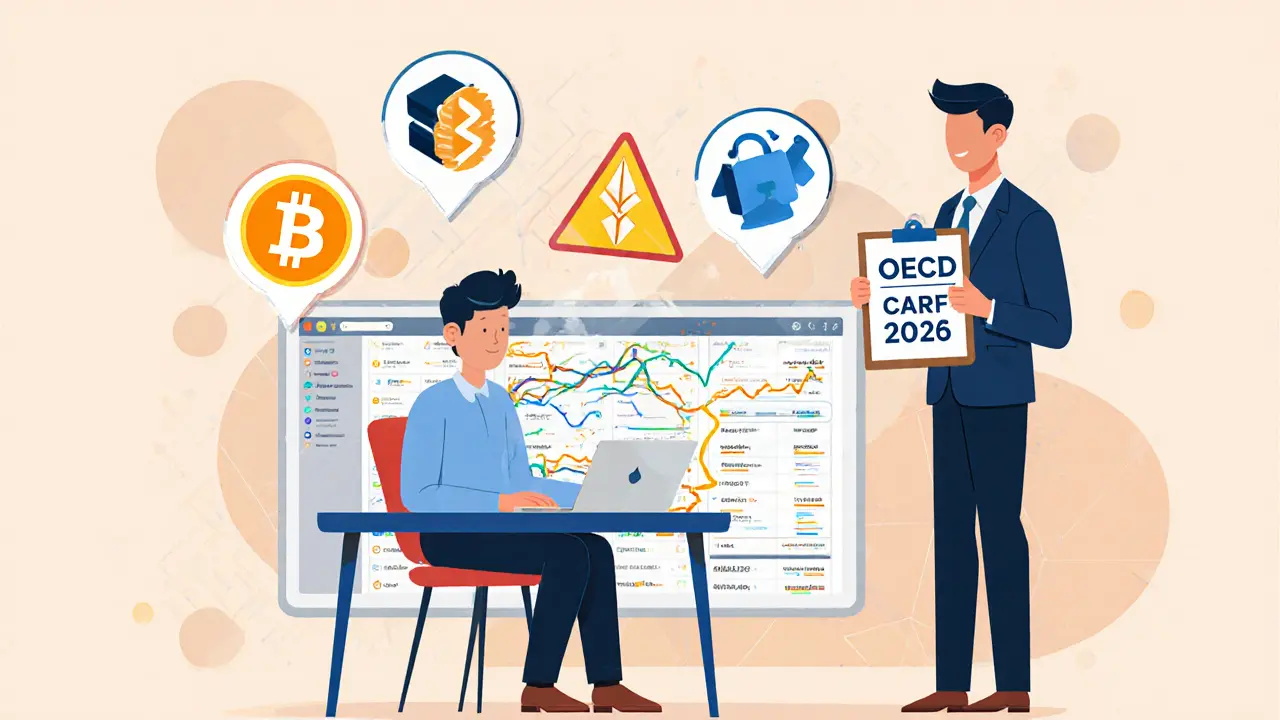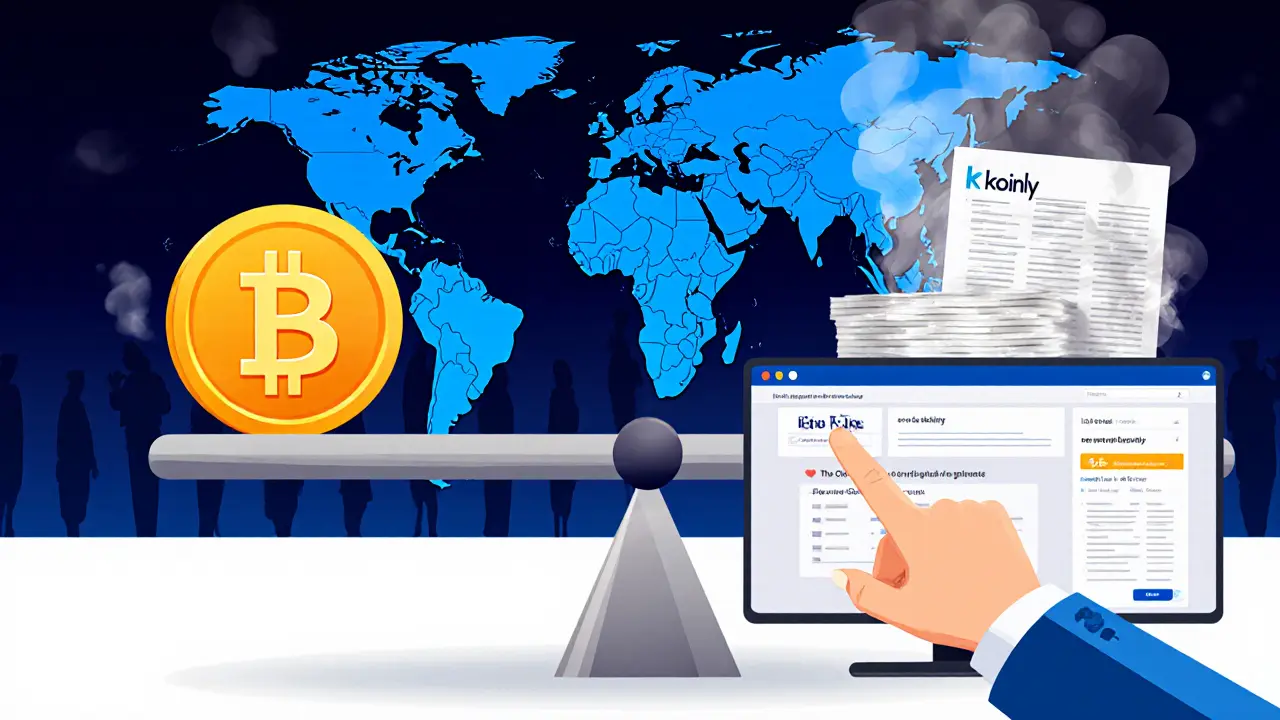Automatic Exchange of Crypto Tax Information Between Countries: What You Need to Know in 2025
 Apr, 3 2025
Apr, 3 2025
Crypto Tax Estimator
Calculate Your Crypto Tax Liability
Estimate potential tax liability based on your crypto transactions. This tool demonstrates CARF reporting requirements but is for informational purposes only.
The world is no longer letting crypto transactions slip through the cracks. Starting in 2026, tax authorities across 67 countries will automatically share detailed records of your crypto trades, staking rewards, and wallet transfers - no request needed. This isn’t a future threat. It’s happening now. If you’ve bought, sold, or held Bitcoin, Ethereum, or any other digital asset in the last year, this system already affects you.
How the Automatic Exchange System Works
At the center of this global shift is the Crypto-Asset Reporting Framework (CARF), created by the Organisation for Economic Co-operation and Development (OECD). Think of CARF as the rulebook that tells countries and crypto platforms what data to collect and who to send it to. It’s built on the same foundation as the Common Reporting Standard (CRS), which has been sharing bank account details between countries since 2014. But now, it’s expanded to cover crypto.
Here’s how it works in practice:
- When you trade crypto on a platform like Coinbase, Binance, or Kraken, the platform - now classified as a Reporting Crypto-Asset Service Provider (RCASP) - collects your personal info, transaction history, and wallet addresses.
- Every year, the platform sends this data to its home country’s tax authority.
- That tax authority then automatically shares the information with the tax agency in the country where you live as a resident.
- If you’re a U.S. citizen living in Germany, Germany gets your U.S.-based crypto trade data. If you’re a Canadian who traded on a Singaporean exchange, Canada gets that data too.
This isn’t optional. Platforms are legally required to report. And if they don’t, they face heavy fines - sometimes up to 5% of their annual revenue. The system doesn’t care if you used a decentralized exchange or a peer-to-peer app. If the platform has a legal presence in a CARF country, it must report.
What Data Is Being Shared?
It’s not just your name and address. Tax authorities will receive a detailed digital trail of your crypto activity:
- Your full legal name and taxpayer ID number
- Your country of tax residence
- Wallet addresses linked to your account
- Types of crypto-assets traded (Bitcoin, Solana, stablecoins, NFTs, etc.)
- Exact dates and amounts of all sales, trades, and transfers
- Fair market value in local currency at the time of each transaction
- Any income earned from staking, lending, or mining
- Names of the platforms you used
This data is sent in a standardized XML format, as defined by the OECD’s October 2024 XML User Guide. That means tax agencies can plug it directly into their systems without manual entry. No more guessing. No more excuses.
Who’s In? Who’s Out?
As of November 2025, 67 jurisdictions have committed to implementing CARF by 2028. That includes nearly every major economy:
- All 27 European Union member states (via DAC8, the EU’s version of CARF)
- The United States
- Canada, Australia, Japan, South Korea
- Switzerland, Singapore, United Arab Emirates
- Most of Latin America and Southeast Asia
The EU is ahead of the curve. DAC8 - its version of CARF - became law in October 2023. EU-based platforms must start collecting data on January 1, 2026, and report it for the first time in 2027. The U.S. is playing catch-up but still participating. The IRS will report on foreign taxpayers using U.S. exchanges and receive data on Americans trading on foreign platforms.
There are still gaps. A few small jurisdictions with lax crypto regulations - like some Caribbean islands - have not yet committed. But even those platforms are under pressure. If you’re a U.S. or EU resident using a non-CARF platform, your home country can still request your data through existing tax treaties. CARF just makes it automatic.

What This Means for You
If you’ve been ignoring crypto taxes, this is your wake-up call. The days of assuming your offshore trades won’t be seen are over. Tax agencies now have a real-time, global view of your digital asset activity.
Here’s what you should do right now:
- Review all your past crypto transactions - even those on platforms you no longer use.
- Calculate your capital gains and income from staking, airdrops, or DeFi rewards.
- File any missing tax returns for 2021 through 2024. Many countries offer voluntary disclosure programs with reduced penalties.
- Keep records of every transaction. Use a crypto tax tool like Koinly, CoinTracker, or ZenLedger to automate calculations.
- Know your residency status. If you moved countries in the last three years, your tax obligations may have changed.
It’s not about avoiding taxes. It’s about avoiding penalties. Fines for undeclared crypto income can reach 75% of the unpaid tax, plus interest. In some countries, repeated non-compliance can lead to criminal charges.
How Platforms Are Adapting
Major exchanges are already rebuilding their systems. Coinbase, Kraken, and Binance have added new onboarding steps: you must now provide your tax residency and taxpayer ID number. Some platforms block users who refuse to comply.
Decentralized platforms like Uniswap or PancakeSwap are trickier. They don’t collect user data. But if you connect your wallet to a centralized exchange to cash out - that’s where the data gets captured. Your wallet address gets linked to your identity the moment you trade on a regulated platform.
Even NFTs are now in scope. If you sold an NFT for ETH on OpenSea and then cashed out to fiat, that sale is reportable. The OECD explicitly included NFTs under CARF’s definition of crypto-assets.

The Bigger Picture: Why This Matters
This isn’t just about tax collection. It’s about legitimacy. For years, crypto was seen as a haven for tax evasion, money laundering, and illicit finance. CARF changes that. It forces the industry to play by the same rules as banks and stock brokers.
That’s good news for honest users. It levels the playing field. Platforms that follow the rules won’t be undercut by shady operators. Investors can trust that the market is more transparent.
It also means crypto is no longer a fringe asset. It’s now part of the global financial infrastructure - regulated, tracked, and integrated. That’s why institutions like BlackRock and Fidelity are entering the space. They need certainty. CARF delivers it.
What’s Next?
By 2027, the first wave of data will start flowing between tax agencies. You’ll see it in your mailbox - a letter from your tax authority asking for clarification on a transaction you forgot to report.
In 2028, the system will be fully operational. Countries will begin sharing data on DeFi yields, cross-chain swaps, and even crypto-backed loans. The OECD is already looking ahead to include AI-driven trading bots and tokenized real estate under the framework.
One thing is certain: the era of crypto anonymity is over. The technology didn’t change. The rules did. And now, the world is watching.
David Hardy
November 23, 2025 AT 19:44Still waiting for the day my DeFi yield gets auto-calculated in TurboTax.
Jody Veitch
November 25, 2025 AT 08:41Amanda Cheyne
November 26, 2025 AT 00:04